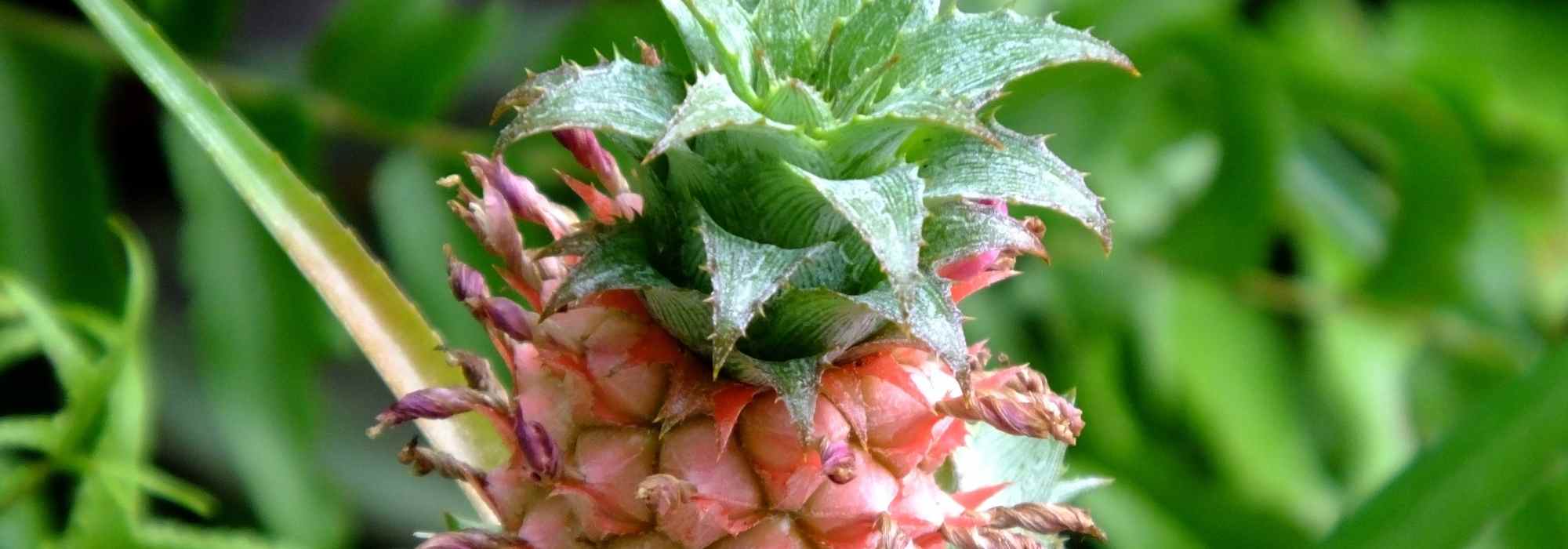
Pineapple : planting, growing, and propagation
Contents
The pineapple in a nutshell
- The pineapple is a lovely indoor plant belonging to the Bromeliaceae family, a cousin of the Aechmea.
- Cultivated by the Native Americans, the pineapple is believed to originate from Brazil.
- The pineapple may occasionally produce fruit in a warm and humid greenhouse, but not indoors.
- This tropical plant requires warmth and a certain level of humidity.
- The pineapple is easy to propagate by dividing the offsets.
The word from our expert
Undoubtedly, the pineapple (Ananas comosus) is the perfect plant to add an exotic touch to your home. Grown for its sweet and flavourful fruit in many tropical and subtropical regions around the world, the pineapple makes for one of the most original ornamental plants in our latitudes. Because, unless you have a heated greenhouse with good humidity, it is completely unthinkable to enjoy a fruit from a pineapple plant grown in our homes. Nevertheless, its grey-green rosette foliage is particularly decorative. A member of the Bromeliaceae family, the pineapple is a close cousin of the Aechmea, the Guzmania, and the Tillandsia. Like them, the pineapple takes at least 4 to 5 years to produce its first flower and thus its first fruit, which is small and lacks any gustatory quality. This is often the stage at which it is purchased. This flowering, which lasts at least 6 months, signals the end of the plant, which then withers. However, offsets formed at the base of the rosette allow your pineapple to live on.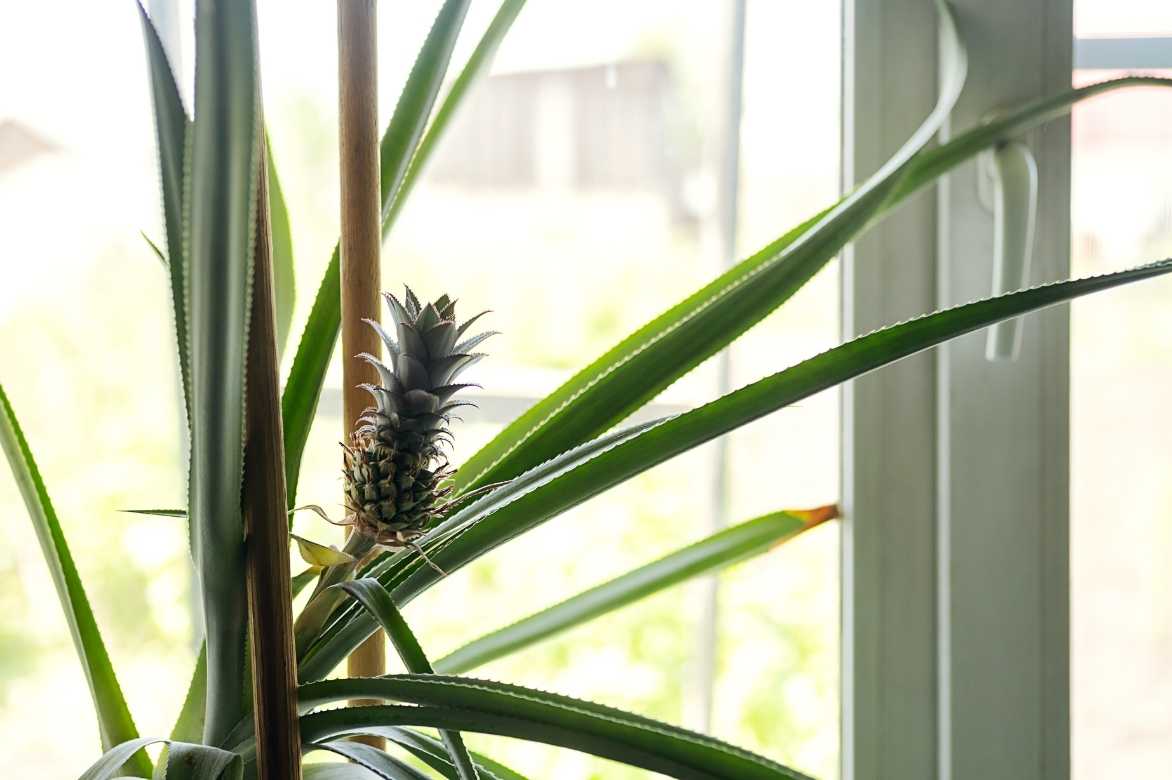
botany
Botanical data
- Latin name Ananas comosus
- Family Bromeliaceae
- Common name Pineapple
- Height Up to 1 m
- Exposure Bright, without direct sunlight
- Soil type Acidic, rich and humus-bearing
- Hardiness Frost-tender
The pineapple (Ananas comosus) is said to have been discovered by Christopher Columbus upon his arrival on the island of Guadeloupe in 1493. Consumed by the indigenous people of Central America, the pineapple took some time to cross the ocean, only arriving on European tables at the beginning of the 16th century, particularly at the Spanish court. However, the consumption of this New World fruit remained very limited, reserved for royal elites. Moreover, it was difficult and fragile to export. In the 17th century, cultivation attempts were made in the greenhouses of royal courts, with little success, given the demanding growing conditions and the lengthy cultivation period. Eventually, the pineapple became a fruit of exceptional rarity, a symbol of success and wealth. A fruit that was displayed more than eaten! Later, it was successfully cultivated in greenhouses, albeit with great effort. Louis XIV is even said to have tasted it! But by the end of the 19th century, the importation of whole plants replaced greenhouse cultivation.
Today, pineapples are produced in South America, Africa, and the French overseas departments and regions. It is the second most consumed tropical fruit after the banana. Completely frost-tender, the pineapple can only be grown indoors in our latitudes, or in a heated greenhouse with high humidity, or in a winter garden, to recreate the tropical climate conditions. Even then, its fruit never matches the quality of imported pineapples.
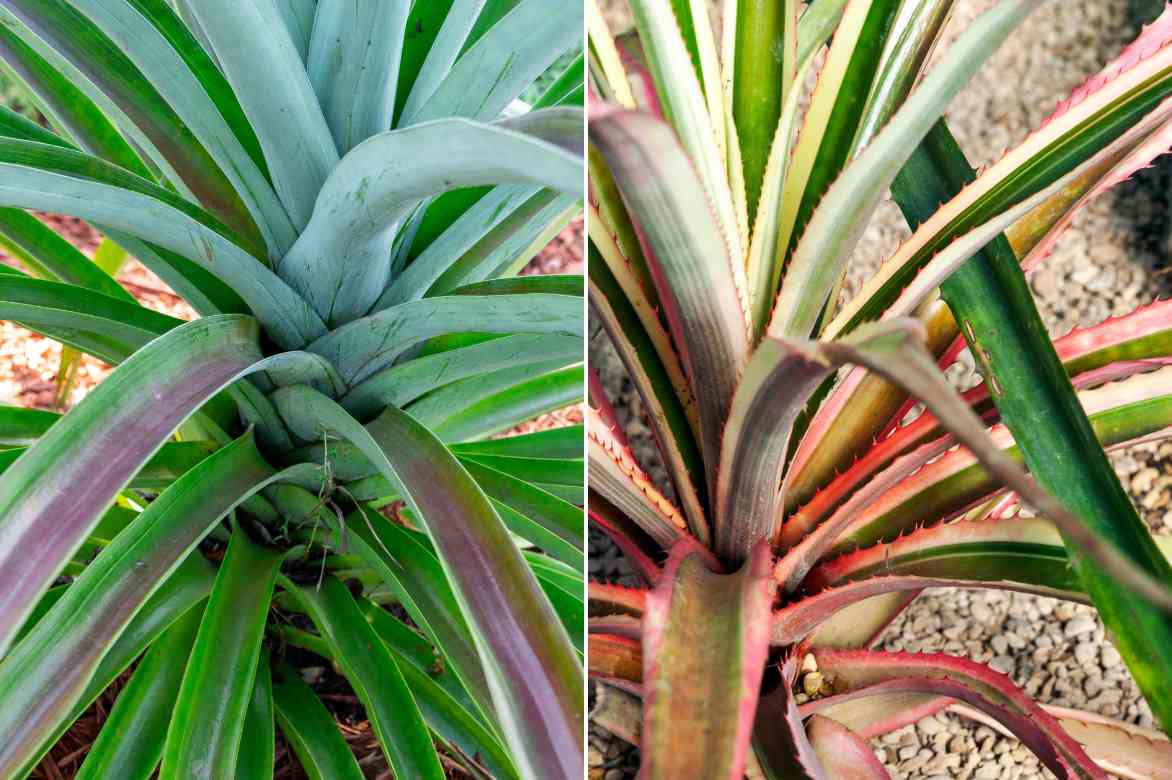
The Ananas comosus type and the variegated variety ‘Variegatus’
Etymologically, the term “pineapple” comes from “nanas,” meaning “delicious fruit” in a South American indigenous dialect. In English, the pineapple is called “pineapple,” a term referring to its resemblance to a pine cone.
Previously named Ananas sativus, the pineapple is now scientifically known as Ananas comosus. A member of the Bromeliaceae family, it is closely related to the Aechmea, Guzmania, Neoregelia, Vriesea, Cryptanthus, and Tillandsia, other tropical and subtropical plants widely cultivated indoors. All of them bring a purely exotic ambiance to your homes. Originally, most Bromeliads are epiphytic plants. However, the pineapple is a terrestrial plant. All are grown as houseplants for their unique colourful inflorescences. This inflorescence takes years to bloom and marks the death of the plant, which occurs about 6 months later. But the offsets that appear at the base replace the parent plant and ensure its lineage.
Ananas comosus consists of a rosette of lanceolate, grey-green leaves that emerge directly from the roots. These stiff, thick, and fleshy leaves curve outward and are edged with thorns. They are rather long, quite narrow, and end in a sharp point. They are arranged in a spiral. In their natural habitat, these leaves can reach 1 m in length. Decorative cultivars offer variety. They differ from the species type by their colourful foliage. For example, Ananas comosus ‘Variegatus’ has variegated, hairy foliage. Its sword-shaped, leathery, ribbon-like leaves are green, margined with white, and edged with pink thorns. The cultivar ‘Porteanus’ is distinguished by a yellow stripe running through the centre of its leaves.
In summer, after 4 to 5 years of cultivation, the pineapple produces small, ovoid, blue-pink flowers surrounded by orange-red bracts, grouped into a compact inflorescence. This unique inflorescence emerges from the centre of the rosette, perched on a tall floral stem 50 cm long. Under favourable weather and growing conditions, each flower develops into a fruit with a scaly bark, forming a pineapple. In a greenhouse or winter garden, warm and humid, it is entirely possible for the pineapple plant to produce a small fruit, but in our homes, it is highly unlikely.
Naturally, given its origins, the pineapple plant is frost-tender. It cannot tolerate winter temperatures below 16 to 18 °C. It is very easy to grow in pots. Commercially, pineapples are most often sold with a fruit on top. It can survive for at least 6 months. Afterward, planting offsets, which rarely appear indoors, or planting the crown that grows at the top of the fruit, allows you to keep your pineapple.
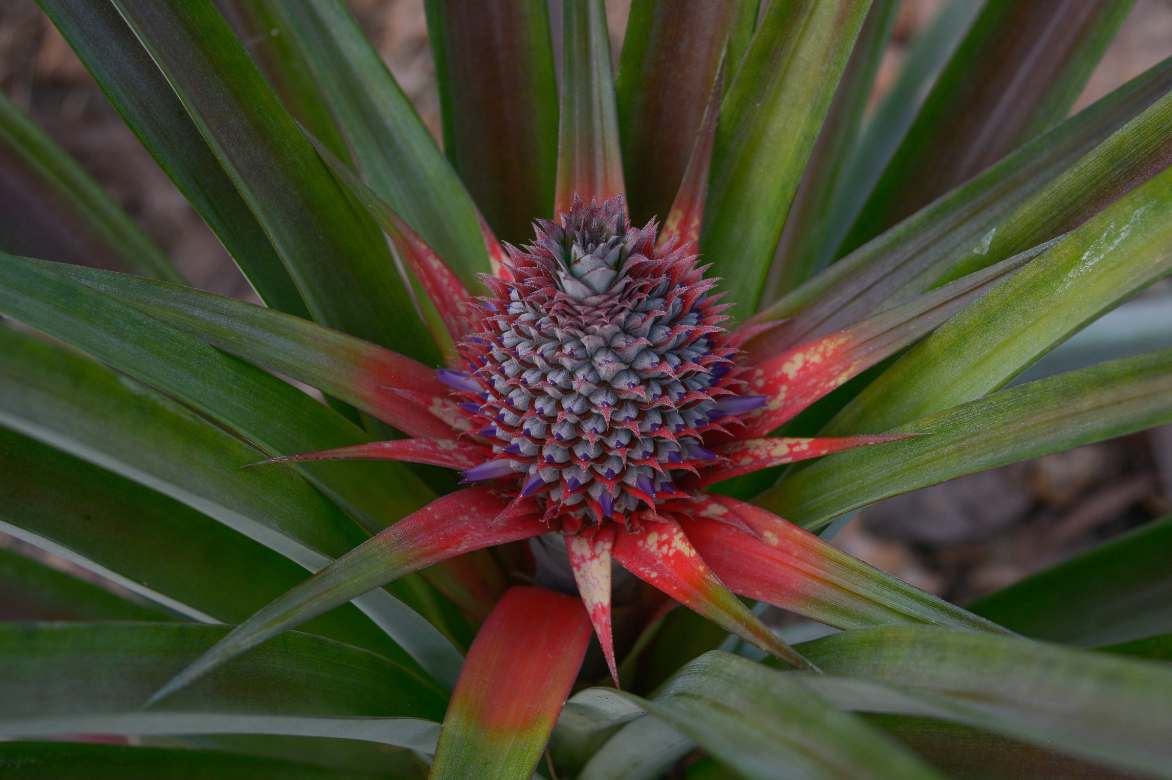
The pineapple flower
Our favourite variety
Pineapple
How to plant a pineapple?
When to Plant Pineapple?
As a houseplant, pineapple can be planted at any time of the year.
How to Plant It?
Pineapple requires a light, rich, porous, and well-draining substrate with a slightly acidic tendency. This substrate can consist of a special Bromeliad compost or, alternatively, a special orchid compost. You can also use a mixture of heather soil, leaf compost, and sand (or perlite).
The pineapple should be placed in the smallest pot possible, almost to the point of instability, as this plant thrives when slightly cramped. However, the pot must have drainage holes. A layer of clay pebbles or pumice can be placed at the bottom.
Of course, after planting, the substrate should be watered thoroughly, ensuring any excess water is drained away.
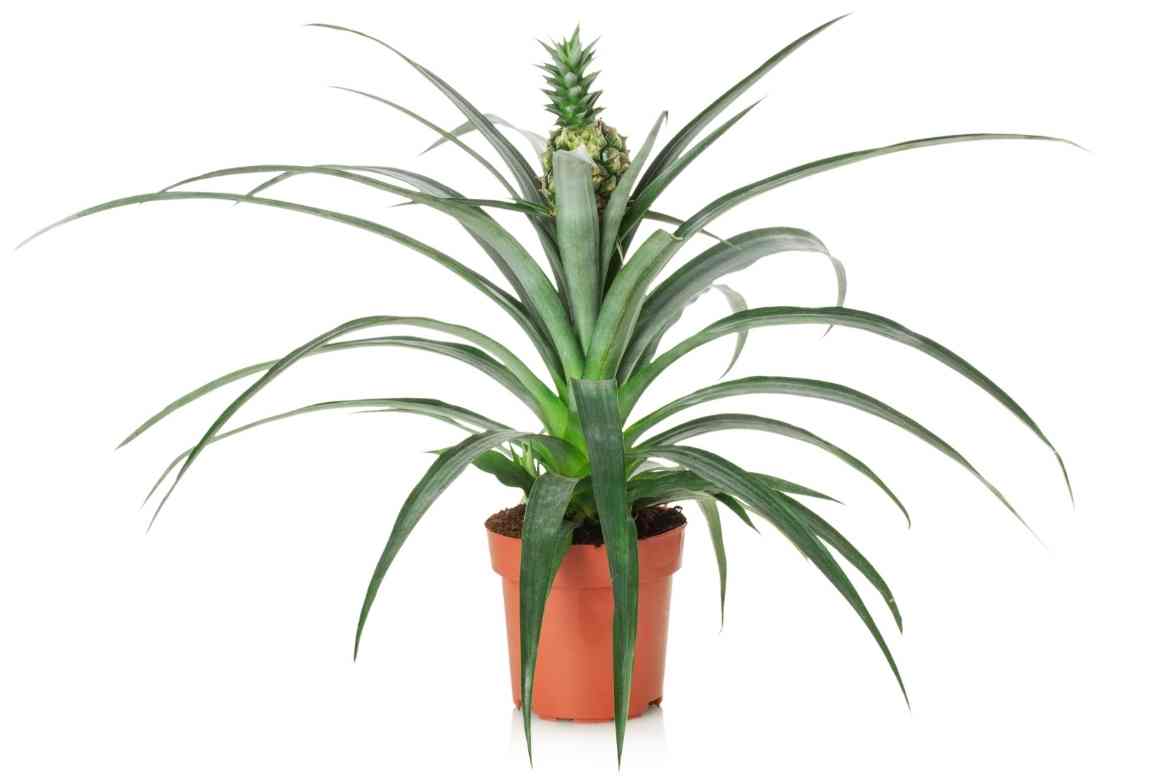
Where to Place It?
Pineapple requires very bright light but should be shielded from direct sunlight during the hottest months, especially for variegated species. It can be placed near a window, provided the window is covered to protect it from harsh sunlight.
Additionally, keep it away from all heat sources such as radiators, wood stoves, or fireplaces. It is also sensitive to drafts.
In terms of temperature, pineapple thrives between 18 and 24°C in a humid environment. It should never be exposed to temperatures below 15°C. In summer, it can be placed outdoors in the garden, in partial shade, as long as it receives very regular and abundant watering.
How to care for your pineapple plant?
To keep your pineapple plant thriving for as long as possible, it requires minimal care, with watering being essential.
Watering
In spring and summer, watering should be very regular but moderate. In autumn and winter, it is significantly reduced. Specifically, during the warmer months, it is recommended to provide the correct amount of water at least twice a week. The pineapple plant loves water but cannot tolerate having its roots sitting in water. Therefore, it is crucial to remove any residual water from the saucer or decorative pot. Essentially, the substrate should remain consistently moist but not waterlogged.
As temperatures cool and during winter, watering should be reduced. Wait until the substrate dries out a few centimetres before watering again.
The water used for watering should be non-calcareous and at room temperature. Ideally, rainwater can be provided for the pineapple plant.
In addition to watering, the pineapple plant should be kept in a consistently humid atmosphere. For this reason, it is recommended to place the pot on a bed of water-soaked clay pebbles. The evaporation of this water helps maintain constant humidity.
Since the pineapple plant belongs to the Bromeliaceae family, it is possible to add a little water to the centre of the rosette. However, this water should be changed regularly to prevent the growth of bacteria.
Fertilisation
A diluted orchid fertiliser is recommended every two weeks during spring and summer.
Repotting
Repotting is unnecessary, as the rosette dies after the fruit is harvested. However, the crown of leaves on the fruit can be replanted.
Pruning
The pineapple plant does not require pruning. However, damaged or dead leaves at the base can be removed to encourage the growth of offshoots.
→ Learn more in Pineapple: Seasonal Care for This Indoor Plant.
How to propagate pineapples?
The propagation of the pineapple can be done in two ways: either by removing and planting offshoots in spring or summer, or by propagating the crown of leaves by cuttings.
- If offshoots have formed at the base of the leaves, they can be cut off after the mother rosette dies and then replanted in a new pot filled with a mixture of leaf compost and sand. To speed up recovery, you can place a plastic bag over the pot to maintain some humidity. Remember to aerate the pot well and water sparingly, ensuring no water stagnates. However, the formation of offshoots remains relatively rare when the pineapple is grown indoors.
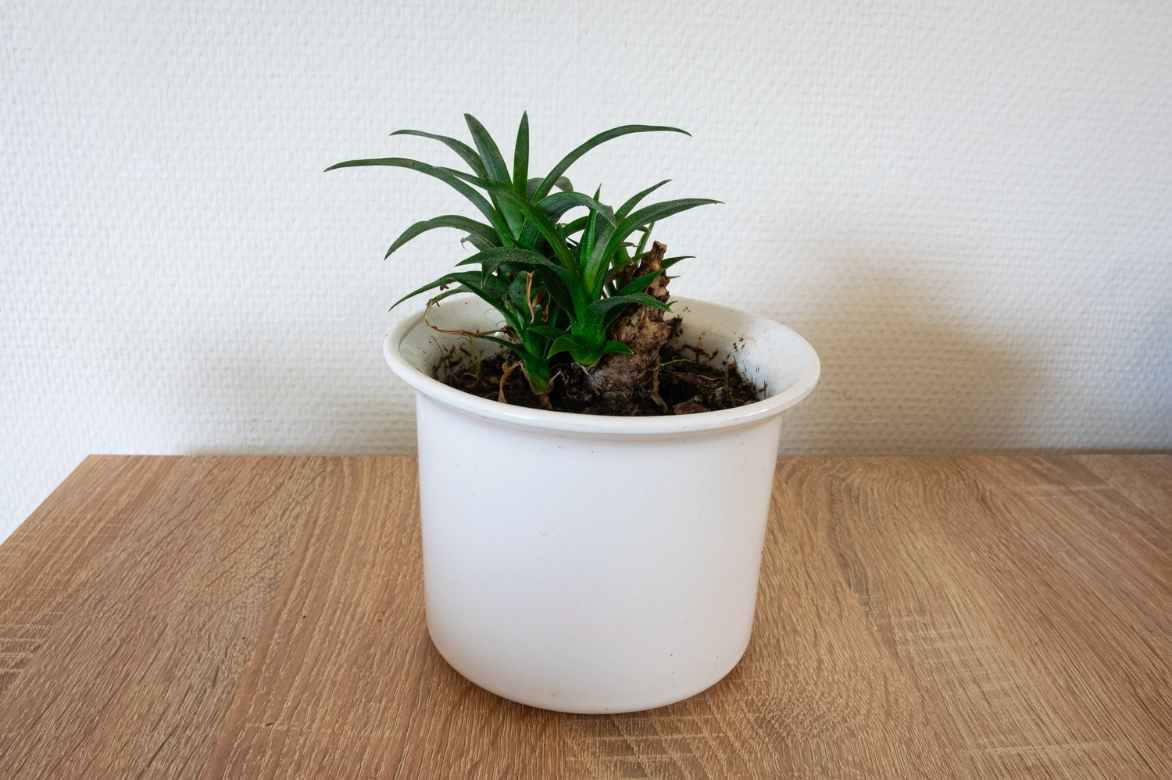
- The second method involves cutting the base of the crown of leaves that develop at the top of the fruit. After allowing the fleshy part of the fruit to dry, remove the first rank of leaves from the crown. Then, you can either place this cutting in water or plant it directly in a mixture of sand and leaf compost. When the cutting, placed in water, has formed tiny rootlets, it can be planted in a sandy mixture. To avoid exhausting the plant, it is recommended to slightly trim the tips of the leaves. The substrate should always be kept moist. A temperature of at least 24°C is required. As is patience, because development takes a few years before you might see a flower appear.
Diseases and Pests of Pineapple
Excess moisture is always harmful to the pineapple. It can lead to fusarium wilt, a rot that causes the wilting of the rosette and the appearance of brown spots on the leaf. Similarly, the tips of the leaves may turn brown. Watering should be spaced out, and any stagnant water should be removed. If the leaf becomes dull and pale, it is likely because your pineapple lacks light. A drooping and softening leaf is often due to an atmosphere that is too dry. Simply mist the leaf and place a saucer filled with moistened clay pebbles under the pot.
Since the pineapple thrives in a warm and humid atmosphere, it can be susceptible to mealybug attacks. I invite you to learn how to combat them in this article: Mealybugs: identification and treatment.
In an atmosphere that is too dry, red spider mites may infest the leaf. Again, I leave you to discover all our tips for getting rid of them in this article: Red spider mites: identification and treatment.
→ To learn more, check out our article: “Diseases and Parasites of the Pineapple: How to Identify and Treat Them?“
How to highlight a pineapple plant?
With its decidedly exotic appearance, the pineapple plant will thrive in a very bright room, such as a conservatory or winter garden. It can easily be paired with plants sharing the same needs, from the Bromeliad family, like the Guzmania with its glossy leaves and red-bracted flowers, the Bromelia with its spike-shaped inflorescences, the Aechmea with its tough, very broad leaves and unique flower, or the Neoregelia, a tropical epiphytic plant that turns red at its centre when flowering.
The Croton, highly decorative with its variegated foliage, and the Peperomia with leaves variously coloured in green or purple, complete this vibrant exotic tableau. Adding a Zamioculcas zamiifolia, better known as the ZZ plant, will bring verticality. Just like the Sansevieria trifasciata ‘Laurentii’, or mother-in-law’s tongue, a succulent with stiff, upright leaves.
The pineapple plant can perfectly fit into a jungle-inspired, tropical décor, where bamboo, exotic woods, and rattan abound. To complete your décor, large exotic plants like the Rubber plant, the Monstera, or a Banana tree, will help create a highly graphic setting… In short, to enhance the jungle effect, don’t hesitate to play with abundance, profusion, or even the exuberance of green plants.
But the pineapple plant can also stand alone, highlighted by a golden ceramic planter.
To go further...
- Feel free to explore our wide range of houseplants
- We also offer numerous books on houseplants to help you refine your knowledge and understand everything about their care or propagation. For instance, Jean-Michel Groult’s book Houseplants – Trendy Plants for a Jungle Effect might interest you if you love pineapple plants.
- Subscribe!
- Contents
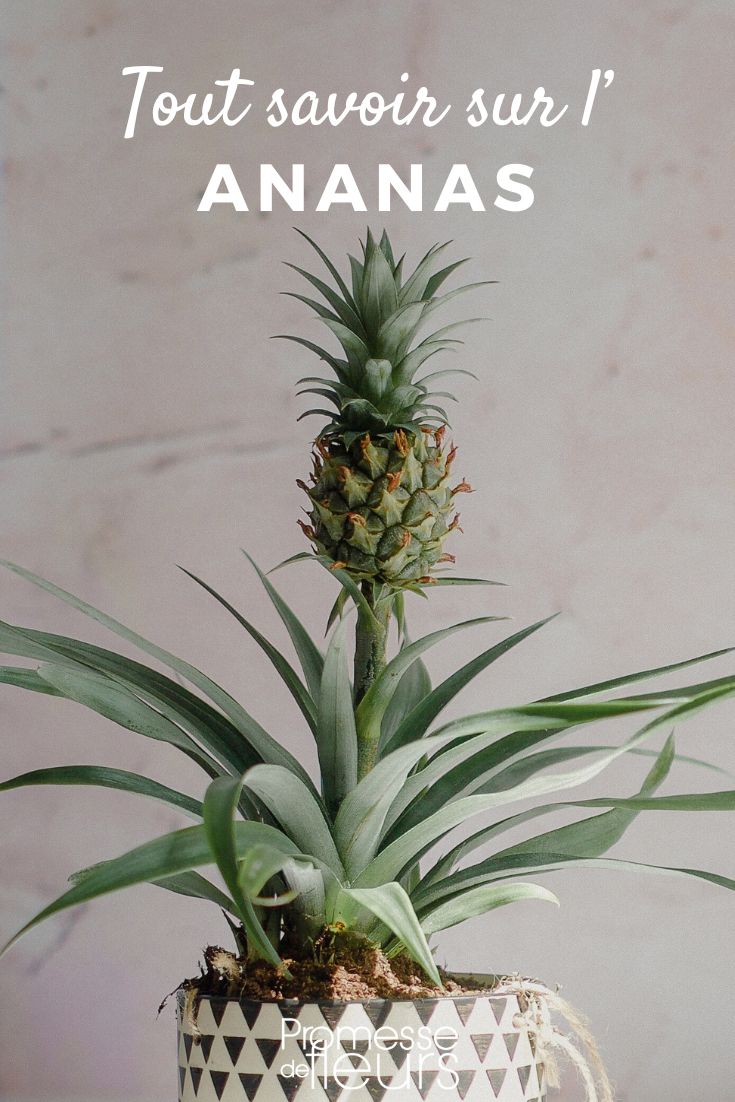































Comments